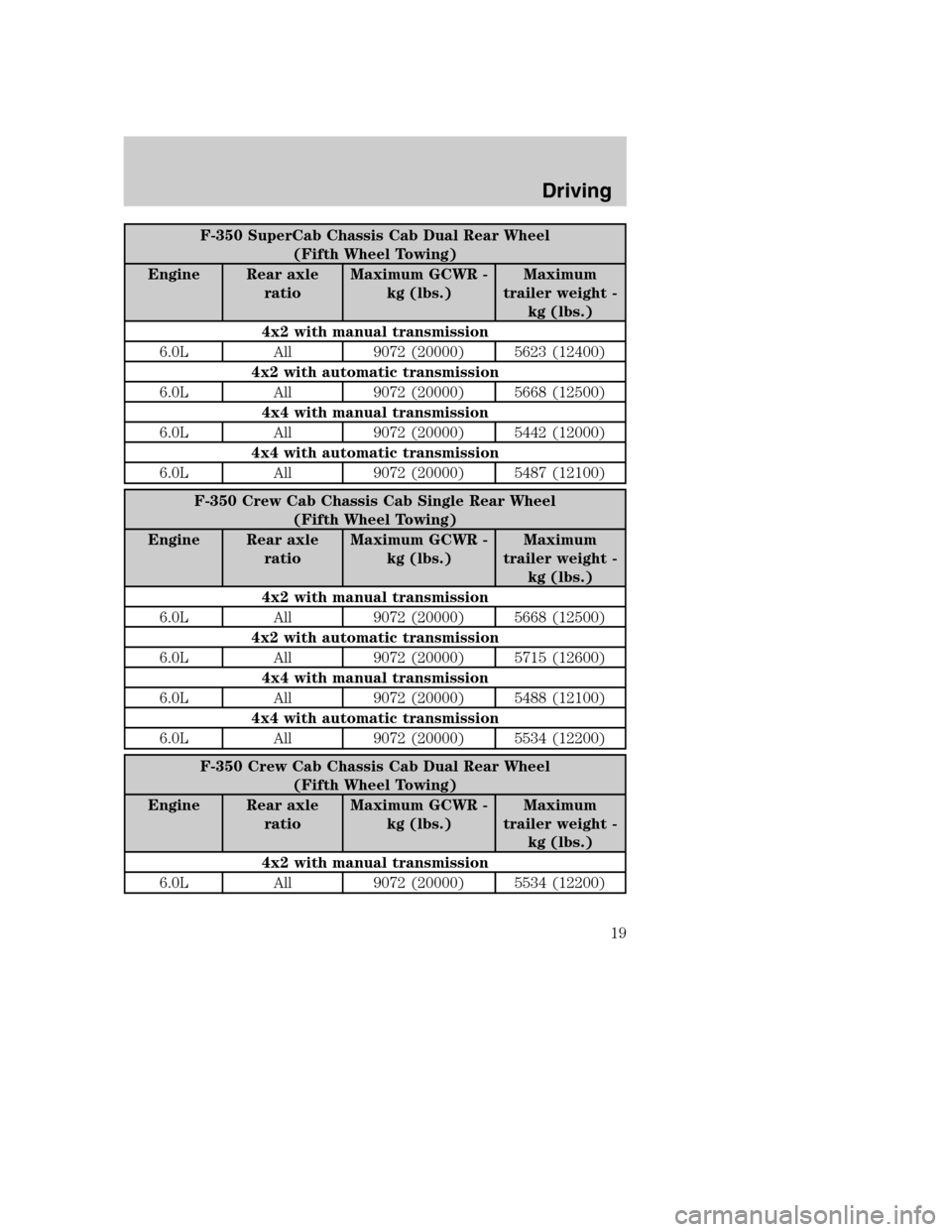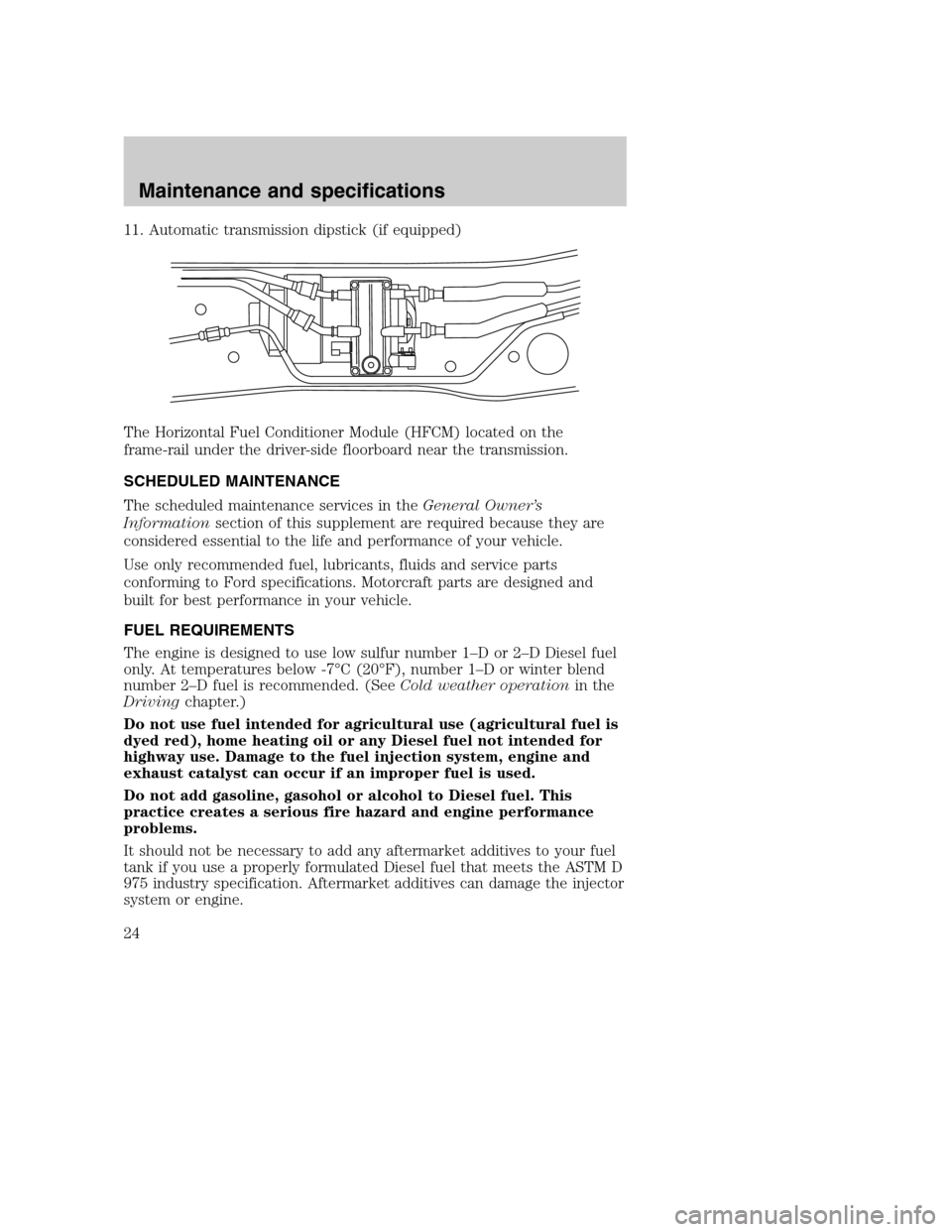Page 18 of 64
F-350 Regular Chassis Cab Single Rear Wheel
(Fifth Wheel Towing)
Engine Rear axle
ratioMaximum GCWR -
kg (lbs.)Maximum
trailer weight -
kg (lbs.)
4x2
6.0L All 9072 (20000) 5942 (13100)
4x4
6.0L All 9072 (20000) 5761 (12700)
F-350 Regular Chassis Cab Dual Rear Wheel
(Fifth Wheel Towing)
Engine Rear axle
ratioMaximum GCWR -
kg (lbs.)Maximum
trailer weight -
kg (lbs.)
4x2
6.0L All 9072 (20000) 5759 (12700)
4x4
6.0L All 9072 (20000) 5532 (12200)
F-350 SuperCab Chassis Cab Single Rear Wheel
(Fifth Wheel Towing)
Engine Rear axle
ratioMaximum GCWR -
kg (lbs.)Maximum
trailer weight -
kg (lbs.)
4x2 with manual transmission
6.0L All 9072 (20000) 5759 (12700)
4x2 with automatic transmission
6.0L All 9072 (20000) 5804 (12800)
4x4
6.0L All 9072 (20000) 5579 (12300)
Driving
18
Page 19 of 64

F-350 SuperCab Chassis Cab Dual Rear Wheel
(Fifth Wheel Towing)
Engine Rear axle
ratioMaximum GCWR -
kg (lbs.)Maximum
trailer weight -
kg (lbs.)
4x2 with manual transmission
6.0L All 9072 (20000) 5623 (12400)
4x2 with automatic transmission
6.0L All 9072 (20000) 5668 (12500)
4x4 with manual transmission
6.0L All 9072 (20000) 5442 (12000)
4x4 with automatic transmission
6.0L All 9072 (20000) 5487 (12100)
F-350 Crew Cab Chassis Cab Single Rear Wheel
(Fifth Wheel Towing)
Engine Rear axle
ratioMaximum GCWR -
kg (lbs.)Maximum
trailer weight -
kg (lbs.)
4x2 with manual transmission
6.0L All 9072 (20000) 5668 (12500)
4x2 with automatic transmission
6.0L All 9072 (20000) 5715 (12600)
4x4 with manual transmission
6.0L All 9072 (20000) 5488 (12100)
4x4 with automatic transmission
6.0L All 9072 (20000) 5534 (12200)
F-350 Crew Cab Chassis Cab Dual Rear Wheel
(Fifth Wheel Towing)
Engine Rear axle
ratioMaximum GCWR -
kg (lbs.)Maximum
trailer weight -
kg (lbs.)
4x2 with manual transmission
6.0L All 9072 (20000) 5534 (12200)
Driving
19
Page 20 of 64

F-350 Crew Cab Chassis Cab Dual Rear Wheel
(Fifth Wheel Towing)
Engine Rear axle
ratioMaximum GCWR -
kg (lbs.)Maximum
trailer weight -
kg (lbs.)
4x2 with automatic transmission
6.0L All 9072 (20000) 5579 (12300)
4x4 with manual transmission
6.0L All 9072 (20000) 5306 (11700)
4x4 with automatic transmission
6.0L All 9072 (20000) 5352 (11800)
F-450
Engine Rear axle
ratioMaximum GCWR -
kg (lbs.)Maximum
trailer weight -
kg (lbs.)
Regular Chassis Cab 4x2 with manual transmission
6.0L All 11793 (26000) 8163 (18000)
Regular Chassis Cab 4x2 with automatic transmission
6.0L All 11793 (26000) 8210 (18100)
Regular Chassis Cab 4x4 with manual transmission
6.0L All 11793 (26000) 8027 (17700)
Regular Chassis Cab 4x4 with automatic transmission
6.0L All 11793 (26000) 8074 (17800)
SuperCab Chassis Cab 4x2
6.0L All 11793 (26000) 8029 (17700)
SuperCab Chassis Cab 4x4
6.0L All 11793 (26000) 7847 (17300)
Crew Cab Chassis Cab 4x2
6.0L All 11793 (26000) 7938 (17500)
Crew Cab Chassis Cab 4x4
6.0L All 11793 (26000) 7802 (17200)
Driving
20
Page 21 of 64
F-550
Engine Rear axle
ratioMaximum GCWR -
kg (lbs.)Maximum
trailer weight -
kg (lbs.)
Regular Chassis Cab 4x2
6.0L All 11793 (26000) 8165 (18000)
Regular Chassis Cab 4x4 with manual transmission
6.0L All 11793 (26000) 7981 (17600)
Regular Chassis Cab 4x4 with automatic transmission
6.0L All 11793 (26000) 8029 (17700)
SuperCab Chassis Cab 4x2
6.0L All 11793 (26000) 8029 (17700)
SuperCab Chassis Cab 4x4
6.0L All 11793 (26000) 7802 (17200)
Crew Cab Chassis Cab 4x2 with manual transmission
6.0L All 11793 (26000) 7893 (17400)
Crew Cab Chassis Cab 4x2 with automatic transmission
6.0L 4.88 11793 (26000) 7891 (17400)
6.0L (with
high
capacity
trailer tow
package)4.88 13608 (30000) 9705 (21400)
Crew Cab Chassis Cab 4x4 with manual transmission
6.0L All 11793 (26000) 7709 (17000)
Crew Cab Chassis Cab 4x4 with automatic transmission
6.0L All 11793 (26000) 7756 (17100)
Driving
21
Page 22 of 64
ENGINE
Engines are more efficient when they are clean because grease and dirt
buildup keep the engine warmer than normal. When washing:
•Take care when using a power washer to clean the engine. The
high-pressure fluid could penetrate the sealed parts and cause
damage.
•Do not spray a hot engine with cold water to avoid cracking the
engine block or other engine components.
•Spray Motorcraft Engine Shampoo and Degreaser (ZC-20) on all parts
that require cleaning and pressure rinse clean.
•Never wash or rinse the engine while it is running; water in the
running engine may cause internal damage.
•Cover the highlighted areas to prevent water damage when cleaning
the engine.
•F–Super Duty/Excursion 6.0L Diesel engine
Cleaning
Cleaning
22
Page 23 of 64
IDENTIFYING COMPONENTS IN THE ENGINE COMPARTMENT
F-SuperDuty/Excursion
1. Battery (dual batteries shown)
2. Air filter assembly
3. Power steering fluid reservoir
4. Clutch fluid reservoir (if equipped)
5. Brake fluid reservoir
6. Engine coolant reservoir
7. Engine oil dipstick
8. Engine-mounted fuel filter assembly
9. Engine oil filter
10. Engine oil filler
Maintenance and specifications
Maintenance and specifications
23
Page 24 of 64

11. Automatic transmission dipstick (if equipped)
The Horizontal Fuel Conditioner Module (HFCM) located on the
frame-rail under the driver-side floorboard near the transmission.
SCHEDULED MAINTENANCE
The scheduled maintenance services in theGeneral Owner’s
Informationsection of this supplement are required because they are
considered essential to the life and performance of your vehicle.
Use only recommended fuel, lubricants, fluids and service parts
conforming to Ford specifications. Motorcraft parts are designed and
built for best performance in your vehicle.
FUEL REQUIREMENTS
The engine is designed to use low sulfur number 1–Dor2–D Diesel fuel
only. At temperatures below -7°C (20°F), number 1–D or winter blend
number 2–D fuel is recommended. (SeeCold weather operationin the
Drivingchapter.)
Do not use fuel intended for agricultural use (agricultural fuel is
dyed red), home heating oil or any Diesel fuel not intended for
highway use. Damage to the fuel injection system, engine and
exhaust catalyst can occur if an improper fuel is used.
Do not add gasoline, gasohol or alcohol to Diesel fuel. This
practice creates a serious fire hazard and engine performance
problems.
It should not be necessary to add any aftermarket additives to your fuel
tank if you use a properly formulated Diesel fuel that meets the ASTM D
975 industry specification. Aftermarket additives can damage the injector
system or engine.
Maintenance and specifications
24
Page 25 of 64

Do not blend used engine oil with Diesel fuel under any
circumstances.Blending used oil with the fuel will significantly increase
your vehicle’s exhaust emissions and reduce engine life due to increased
internal wear.
Do not crank the engine for more than 30 seconds at a time as
damage to the starter motor may result.
If the engine fails to start in 30 seconds, turn the key to the OFF
position and wait 30 seconds before trying again.
Truck stops have pumps and nozzles designed for larger, heavy-duty
trucks. When refueling at truck stops: if the nozzle shuts off repeatedly
when refueling, wait 5–10 seconds; then use a slower rate of flow (don’t
depress the nozzle trigger as far).
If air is allowed to enter the fuel system (during fuel filter change or if
you run out of fuel) the engine will purge the trapped air as it runs. The
engine may run rough and produce white smoke while air is in the
system. This is normal and should correct itself in a short time.
An engine that suddenly becomes noisy or operates poorly after a fuel fill
could be using substandard fuel (i.e., high water content, low cetane
rating or gasoline in the fuel). Diesel fuel should be purchased from a
reputable station which sells a large amount of Diesel fuel.
Care should be taken whenever Diesel fuel is stored. Use only clean,
approved containers which will prevent the entry of dirt or water.
Diesel fuel must not be stored in a galvanized container. The fuel will
dissolve the zinc in a galvanized container. The zinc will then remain in
solution until it is run through the engine where it will be deposited in
the fuel injectors causing expensive-to-repair damage.
Diesel fuel dispensing nozzle fill rate
This truck is equipped with a fuel fill pipe which is able to accept fuel up
to 20 gallons per minute from an 1 1/8 inch fuel dispensing nozzle.
Pumping fuel at greater flow rates may result in premature nozzle
shut-off or spitback.
HORIZONTAL FUEL CONDITIONING MODULE (HFCM)
(FUEL FILTER/WATER SEPARATOR)
The vehicle is equipped with a Horizontal Fuel Conditioning Module
(HFCM) located on the frame-rail under the driver-side floorboard near
the transmission.
Maintenance and specifications
25